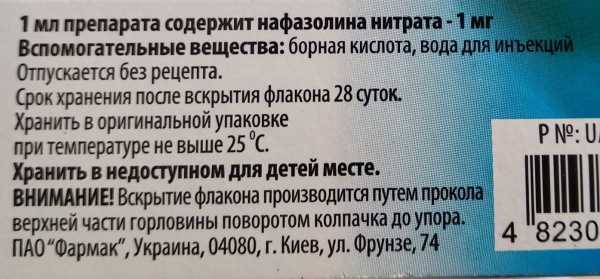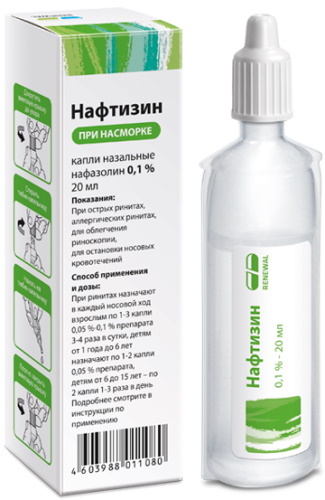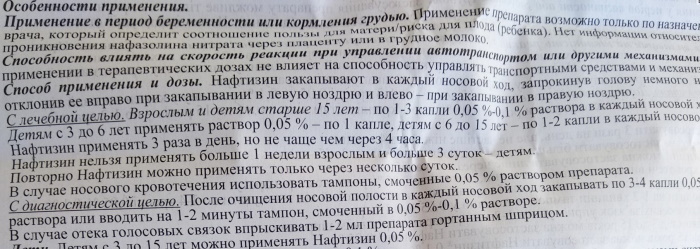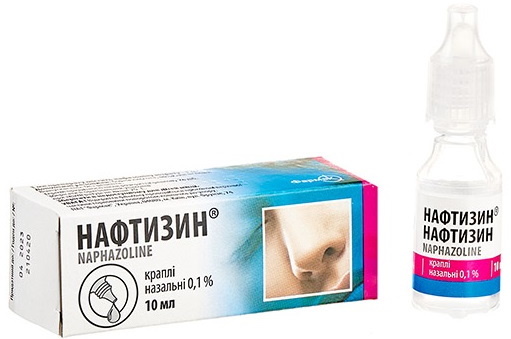Content
- Composition and form of release
- Pharmacological properties
- Pharmacodynamics and pharmacokinetics
- Is it possible during pregnancy, indications for use
- Contraindications
- Methods of administration and dosage
- Side effects
- Overdose
- special instructions
- Drug interactions
- Analogs
- Terms of sale, storage, prices
- Video about the drug Naphtizin
Naphthyzin is a domestic drug, which is used to eliminate the common cold. The tool quickly and for a long time relieves nasal breathing with rhinitis, which has gained popularity among patients and doctors. Further in the publication, it is considered whether it is possible to use the medication during pregnancy and what dosage is required for each trimester.
Composition and form of release
The drug is presented in the form of a transparent solution, which is placed in plastic bottles equipped with a dispenser and a lid with tamper evident or in glass "jars" closed with a rubber lid and an aluminum cap. The amount of the product in the bottle is 10, 15 and 20 ml.
The medicinal properties of Naphthyzin are provided by the following composition:
| List of components | Characteristics of elements |
| Main component | |
| Naphazoline nitrate | The substance has a vasoconstrictor, anti-inflammatory and anti-edema effect. In addition, the component helps to increase the pressure. |
| Excipients | |
| Boric acid | The element has an antiseptic and antiparasitic effect. |
| Purified water | The component is necessary to combine the components and to give the solution the desired concentration. |

Naphthyzin is produced with a concentration of the main component of 0.05 and 0.1%. Vials are placed, along with instructions, in cardboard packaging.
Pharmacological properties
Naphthyzine belongs to the group of vasoconstrictor drugs for the relief of nasal breathing with rhinitis.
Pharmacodynamics and pharmacokinetics
Naphthyzine during pregnancy, trimester (period of bearing a child) any, has the following effect on the body:
- the main component has pronounced vasoconstrictor properties. Thanks to this action, there is a decrease in the swelling of the mucous membranes, a decrease in the amount of nasal discharge, and the elimination of the sensation of heat and irritation in the nose;
- the inflammatory process in the tissues of the nose is eliminated;
- has an expanding effect on the ducts of the sinuses of the nose, helping to improve the outflow of secretions;
- there is a slight increase in pressure due to vasoconstriction;
- minor components (boric acid) contribute to the destruction of bacteria, fungus and parasites. In this case, the agent is toxic.
After using Naphthyzin, the normalization of nasal breathing occurs within about 1 minute. The achieved effect lasts up to 12 hours (depending on the severity of the symptoms of rhinitis). It should be borne in mind that after approximately 5-7 days of therapy, the body develops addiction to the active substance, as a result, the effectiveness of the drug is significantly reduced.
Naphthyzine may also be prescribed by a doctor to treat redness in the eyes caused by an allergic reaction. Additionally, the drug eliminates itching, gritty eyes and increased tearing.
Is it possible during pregnancy, indications for use
The instructions for Naphtizin indicate that when carrying a child, the agent can be used only with the permission of a doctor and provided that the required benefit to the mother outweighs the risks. The restriction on the use of the medication is based on its vasoconstrictor properties, as a result of which the vessels of the placenta are narrowed. Because of this action, the fetus does not receive the required amount of oxygen and nutrients, as a result, the child develops hypoxia, and development slows down.

Naphthyzin can be prescribed to a pregnant woman in the following cases:
- sparing drugs did not give the desired effect;
- nasal congestion and profuse runny nose persist for more than 7 days;
- the presence of the likelihood of rhinitis becoming chronic;
- a runny nose is of a bacterial or fungal nature;
- inflammation in the tissues of the nose without severe rhinitis;
- the development of inflammation processes in the tonsils of the pharynx and in the lymphoid tissue;
- severe redness and swelling of the mucous membranes in the nose;
- a runny nose proceeds in an acute form, accompanied by a high fever;
- prolonged bleeding (not profuse). Due to the vasoconstrictor action, bleeding stops quickly;
- the development of inflammation processes in the larynx or the presence of pronounced swelling in the organ;
- severe allergic rhinitis, which is harmful not only to the mother, but also to the child;
- the need for vasoconstriction before manipulation. Naphthyzine is used to stop bleeding (for example, a pregnant woman broke her nose and requires minor surgery). Additionally, thanks to Naphthyzin, the dosage of anesthetics is reduced, which can cause more harm to the fetus than this drug;
- to reduce swelling before examining the tissues of the nose.
Additionally, the drug is prescribed when, due to a prolonged runny nose, an inflammatory process begins to develop in the ear canals. To eliminate redness of the eyes, which is caused by allergies, Naphthyzin for pregnant women is not used, since there are effective and safer remedies.
Contraindications
Naphthyzine during pregnancy (1 trimester is the most vulnerable to the fetus, although it is undesirable to use the drug at all stages of gestation) not prescribed if the patient has the following prohibitions:
- high susceptibility to droplet composition;

- the presence of high blood pressure, since an additional increase in the indicator in the early stages can cause a miscarriage, and in the later stages it can cause premature birth;
- pronounced violation of the state of the vessels, due to the vasoconstrictor properties, the development of internal bleeding is not excluded;
- disruption of the thyroid gland with an increase in the production of hormones;
- increased intraocular pressure;
- serious eye pathologies;
- chronic rhinitis;
- atrophy of the mucous membranes of the nose and nerve endings caused by a prolonged runny nose;
- the presence of diabetes mellitus in a pregnant woman;
- increased dryness of the mucous membranes in the nose. Naphthyzin will intensify this symptom, as a result, the pathology can turn into a more severe form;
- increased heart rate.
Naphthyzin is prescribed with extreme caution if a pregnant woman has pain in the region of the heart.
Methods of administration and dosage
Naphthyzin during the period of bearing a child is not a safe remedy, therefore, when prescribing a drug by a doctor, it is required to strictly observe the dosage prescribed by him. In cases where the pregnant woman does not have individual restrictions on use, the medication can be used according to the instructions below.

Dosing rules and course of use of Naphthyzin according to the duration of pregnancy and the purpose of use:
| Purpose of use | Trimester | Dosage | Well |
| Rhinitis in acute form | 1 | Apply 1-2 drops up to 3 times every 24 hours. | 24-48 h |
| 2 | Assign 2 drops up to 3-4 times per knock. | 2 days | |
| 3 | Use 2-3 drops up to 4 times a day. | 3 days | |
| Prevention of the development of chronic rhinitis | 1 | Instill 1-2 drops in the morning and evening. | 2-3 days |
| 2 | Apply 2 drops in the morning and evening. | 2-3 days | |
| 3 | Assign 3 drops in the morning and evening. | 2-3 days | |
| Runny nose of an infectious nature | 1 | Use 2 drops 2-3 times a day. | 2-3 days |
| 2 | Instill 2-3 drops 2-3 times in 24 hours. | 3 days | |
| 3 | Apply 3 drops 3 times a day. | 3 days | |
| Nasal congestion without a runny nose | 1 | Assign 1 drop in the morning or at bedtime. | 24-48 h |
| 2 | Use 1 drop in the morning and in the evening. | 48 h | |
| 3 | Instill 2 drops in the morning or evening. | 2 days | |
| Development of inflammation and swelling in the upper respiratory tract | 1 | Apply 2 drops in the morning and evening. | 2-3 days |
| 2 | Assign 2-3 drops in the morning and evening. | 2-3 days | |
| 3 | Use 3 drops in the morning and evening. | 3 days | |
| Stopping bleeding | 1 | Instill 1-2 drops no more than 2 times every 24 hours. | 1 day |
| 2 | Apply 2 drops up to 2 times a day. | 1 day | |
| 3 | Assign 2-3 drops up to 2 times every 24 hours. | 1 day | |
| Severe allergic rhinitis | 1 | Use 2 drops up to 3 times a day. | 48 h |
| 2 | Instill 2 drops up to 4 times a day. | 2 days | |
| 3 | Apply 3 drops up to 4 times every 24 hours. | 2-3 days | |
| Carrying out manipulations in the tissues of the nose | 1 | Prescribe 1-2 drops before the procedures. | — |
| 2 | Use 2 drops before manipulation. | — | |
| 3 | Instill 2-3 drops before the procedure. | — | |
| Otitis media and prevention of its development | 1 | Apply 2-3 drops in the morning or evening. | 2-3 days |
| 2 | Assign 3 drops 3 times every 24 hours. | 72 h | |
| 3 | Use 3 drops up to 4 times a day. | 3 days |
Changing the dosage, prolonging the course, using the drug without a doctor's prescription is strictly prohibited. The solution should be injected into each nostril, even if only one nasal passage is blocked. And also it should be borne in mind that you should use Naphthyzin with an active substance concentration of 0.05%.
Before starting treatment, in order to achieve maximum effect, you should familiarize yourself with the following rules for using drops:
- Free nose of mucus or crusts. To do this, you need to blow your nose and rinse the nasal passages with saline or sea water.
- Blow out any remaining rinsing agent.
- Rinse your hands thoroughly and open the bottle.
- The pregnant woman should lie down and turn her head to the right side.
- Dip the solution into the left nostril and massage gently with your finger so that the components of the drug are evenly distributed in the mucous membrane. Lie down for about 1-2 minutes.
- Turn your head to the left side and similarly inject the drug into the right nostril.
- Close the bottle and rinse your hands again.
After using Naphthyzin, it is undesirable to blow your nose for 5-10 minutes, and also try to restrain sneezing attacks. Otherwise, the great honor of the drug will come out.

If Naphthyzin is used for treatment in a glass container, then separate pipettes are used for instilling the agent, which must be sterilized in advance, and after use they are washed, dried and stored in a special case.
During pregnancy, you cannot instill the drug while standing, tilting your head back, since dizziness may develop and you can lose your balance. Additionally, most of the solution, in this position, flows into the esophagus, causing even more harm to the fetus.
Side effects
Naphthyzine, even when used in compliance with the rules of use, during pregnancy (in any trimester) is dangerous with the following side effects:
- a significant decrease in the sense of smell due to a deterioration in the functioning of receptors;
- lethargy, weakness;
- slight tremor of the limbs;
- increased irritability and nervousness;
- headache and dizziness due to vasoconstriction;
- nausea and abdominal pain;
- an increase in blood pressure;
- increased heart rate;
- violation of the rhythm of the contraction of the heart;
- dryness and burning sensation in the nasal cavity;
- redness of the nose;
- violation of the state of blood vessels;
- the development of nosebleeds as a result of increased dryness and vascular disorders;
- increased swelling of the nasal mucosa;
- impaired development of the child in utero due to poor nutrition;
- the development of oxygen starvation in the fetus;
- addictive. With prolonged use, the remedy ceases to provide the required effect and in addition there is a high probability that the runny nose will turn into a chronic one;
- deterioration of the thyroid gland;
- exacerbation of diabetes symptoms (if the pregnant woman is diabetic);
- soreness in the eyes;
- increased drowsiness;
- increased sweating and pallor of the skin;
- when used for more than 1 week, the development of tissue atrophy in the nose is not excluded.

If a pregnant woman has an intolerance to the composition, then the use of Naphthyzin can cause the development of allergies in the form of: choking, coughing and increased runny nose.
Overdose
An overdose of Naphthyzin can develop in 3 cases: self-prolongation of the course, exceeding the permissible dosage and accidental swallowing of the solution.
Regardless of the reasons listed, the symptoms of poisoning can be as follows:
- lack of smell;
- loss of consciousness;
- profuse vomiting and severe abdominal pain;
- the development of seizures;
- severe aggression or apathy;
- Strong headache;
- a sharp increase in the pressure value;
- severe tachycardia (the number of heart contractions is greatly increased);
- violation of the rhythm of heart contractions (stoppage is not excluded);
- soreness in the nose, accompanied by frequent nosebleeds;
- deterioration of the vascular condition, the development of internal bleeding is possible;
- the development of puffiness not only in the mucous membranes of the nose, but also in the organs of the digestive tract;
- severe oxygen starvation in the fetus;
- the development of deviations in the child due to insufficient supply of oxygen and nutrients;
- disruption of the thyroid gland;
- the development of diabetes, and in the presence of pathology, the development of a coma is possible;
- constant sleepiness;
- heart failure;
- respiratory failure due to pulmonary edema;
- pronounced thinning of tissues in the nose or their death;
- severe pallor of the skin, cyanosis of the nasolabial triangle;
- a sharp decrease or vice versa an increase in body temperature, chills;
- mental abnormalities (hallucinations, tearfulness, mood swings);
- in the presence of allergies, the development of anaphylactic shock is not excluded.

If an overdose occurs with a single injection of the drug into the nose, then you can immediately rinse the nose, do a gastric lavage, after which the victim must take sorbents. Further use of the drug is contraindicated, even after the normalization of health.
When the poisoning happened due to a long course, then you need to immediately stop using the medication and take sorbents. Additionally, symptomatic therapy is performed.
If an overdose has occurred as a result of swallowing the solution, then it is necessary to rinse the injured stomach in a short time and give sorbents to take. Further, an examination of the pregnant woman in the hospital is required, in order to detect a malfunction of the mother's organs, to determine the blood supply in the placenta and the general condition of the fetus.
special instructions
Naphthyzine during pregnancy (any trimester of fetal development) should be used only after consulting a doctor and familiarizing yourself with the following nuances:
- when instilled into the nose, make sure that the solution does not get on the mucous membranes of the eyes;
- it is strictly forbidden to independently change the dosage and prolong the course of therapy;
- after each instillation, wipe the dropper dispenser with a disinfectant napkin or sterilize the pipette;
- the solution has a mild toxic effect on the body, therefore, after completing the course, you should remove the remnants of the medication and toxins with sorbents;
- in the absence of effect after a day, the use of the medication must be discontinued;
- before instillation, it is imperative to clear the nasal passages to increase the effectiveness of Naphthyzin;
- when using the product, it is advisable to avoid driving a vehicle.
It is forbidden to use Naphthyzin for more than 1 week due to the development of addiction. The drug not only becomes ineffective, but also develops dependence on the drug.
Drug interactions
Naphthyzine is allowed to be used in combination treatment, but at the same time it is necessary to take into account what drugs the drug is combined with. Therefore, the selection of medicines should be carried out by the attending physician.

Naphthyzine should be used with caution with the following drugs:
- antidepressants. The joint use of funds causes a pronounced disruption of the heart. Therefore, Naphthyzin can be prescribed if at least 2 weeks have passed after the end of the course of using antidepressants;
- anesthetic medications. Naphthyzine slows down their absorption, so the dosage of these drugs must be reduced.
You can not use Naphthyzin with other drugs of vasoconstrictor action, as the likelihood of side effects from both drugs increases.
Analogs
Naphthyzine during pregnancy (the trimester of fetal development must be taken into account when choosing the dosage of the drug) can be replaced with the following less dangerous drugs:
| Analogue name and price | Main component | Distinctive characteristics |
| Sanorin. It costs about 70 rubles. for 10 ml. | The active substance is identical to the original. | Due to the similarity of the composition, the use of the product is similar to that of Naphtizin. |
| Xymelin. The price is about 150 rubles. for 10 ml. | The main component is xylometazoline. | Despite the different composition, the rules for using the product are identical. |
| Lazorin Cost approximately 500 rubles. for 10 ml. | The multicomponent preparation quickly normalizes nasal breathing. | The rules for using the medication are similar to Naphthyzin. |
In addition to the funds considered, the replacement of Naphthyzin can be carried out with the following analogs:
-
Otrivin. A product based on xylometazoline. The approximate price is 150 rubles. for 10 ml;

Otrivin nasal spray with menthol - Nazivin. The drug is also based on xylometazoline. Estimated cost 150 rubles. for 10 ml;
- Galazolin. The main component is xylometazoline. The approximate cost is 33 rubles. for 10 ml;
- Lazolvan Reno. The main constituent of tramazolin. The approximate price is 250 rubles. for 10 ml;
- Afrin. The active ingredient is xylometazoline. Estimated price 250 rubles. for 10 ml;
- Rhinorus. The main element is xylometazoline. The approximate cost is 30 rubles. for 10 ml.
- Nazol Baby. An analogue based on phenylephrine. The approximate price is 200 rubles. for 10 ml.
During the period of bearing a child, only a doctor should select analogues. Since it is necessary to take into account the period of bearing a child, select an individual dosage and take into account the reason for replacing the product.
Terms of sale, storage, prices
You can buy Naphtizin on free sale. At home, the drug should be stored at a temperature of 4-25 degrees with a plus sign. Also, the place should be darkened and away from children. The shelf life of a sealed bottle is 36 months from the date of manufacture and up to 30 days after opening.
The cost of the medication depends on the concentration of the active substance, the volume of the bottle and the region of sale. The data is provided in the table below.
| Drug concentration | Vial volume | Price range |
| 0,05% | 10 ml | RUB 27-35 |
| 15 ml | 30-40 rubles. | |
| 20 ml | RUB 45-60 | |
| 0,1% | 10 ml | RUB 30-45 |
| 15 ml | 35-50 rubles. | |
| 20 ml | RUB 58-73 |
The lowest price for Naphtizin with a concentration of 0.05% and a volume of 10 ml is listed on the Internet from 17 rubles.
Naphthyzine attracts the attention of patients at a low cost and proven effectiveness. It should be borne in mind that the drug has quite serious side effects that can harm the fetus during pregnancy. The most vulnerable are the 1st and 3rd trimesters of bearing a child.
Author: Kotlyachkova Svetlana
Video about the drug Naphtizin
Naphthyzin solution description and instructions:



